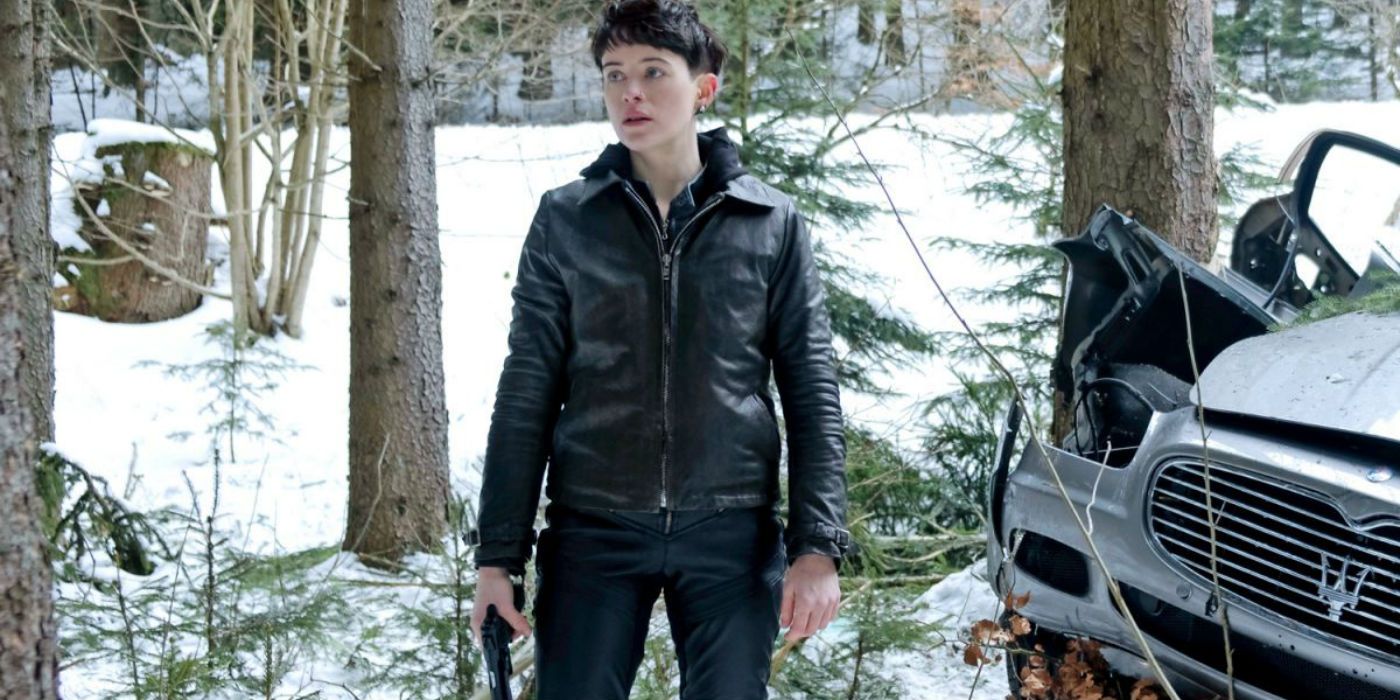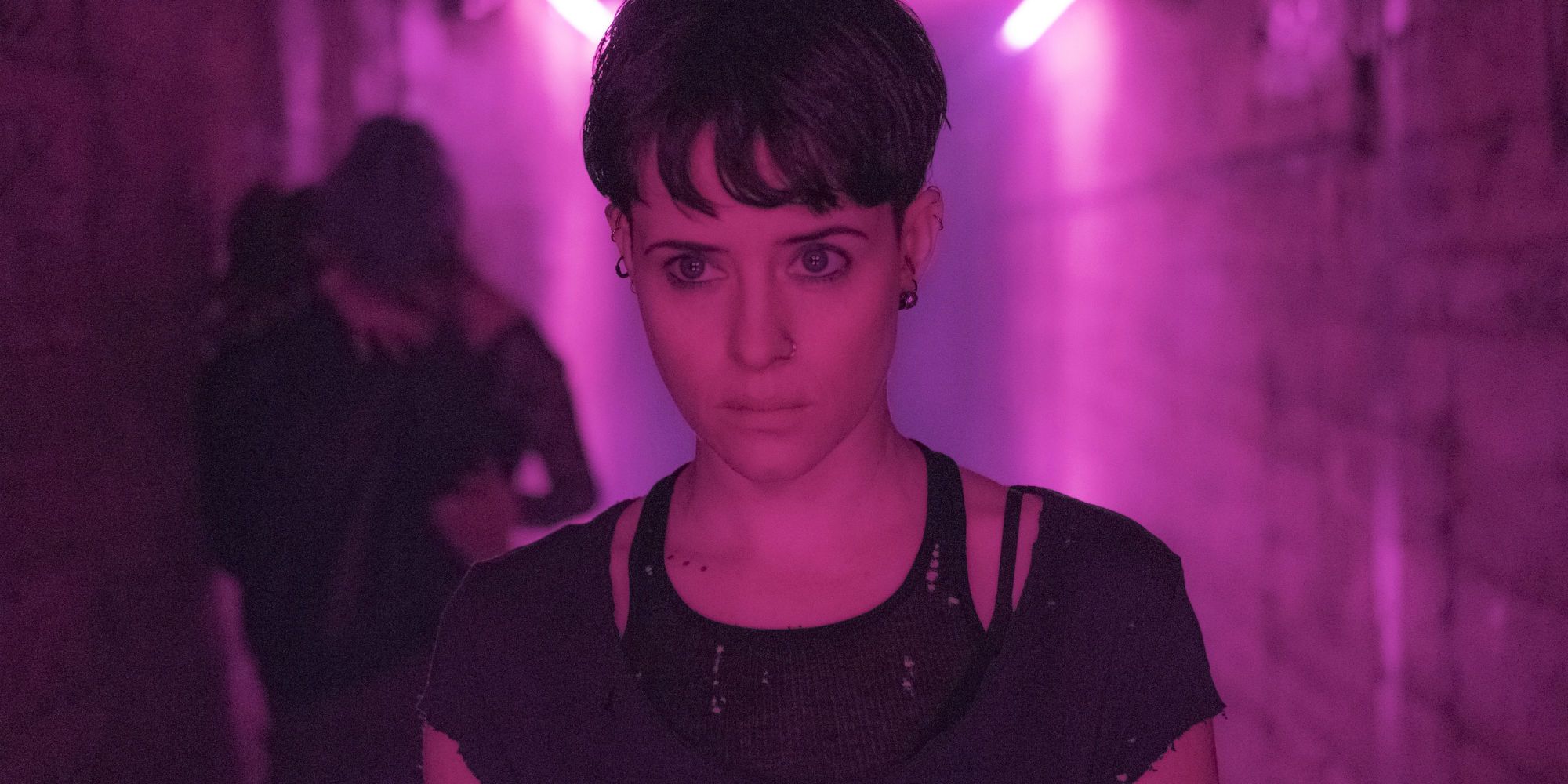
Warning: SPOILERS below for The Girl in the Spider's Web
-
In The Girl in the Spider's Web, Lisbeth Salander's past comes back to haunt her as she finds herself trying to save the world from her own twisted sister. Directed by Fede Álvarez (Don't Breathe), the cyber espionage-thriller stars Golden Globe-winner Claire Foy (The Crown) as Salander. The film is both a soft-reboot and a sequel to David Fincher's 2011 adaptation of The Girl with the Dragon Tattoo, and ignores the next two books in author Stieg Larsson's Millennium trilogy. Instead, The Girl in the Spider's Web adapts the fourth novel, which was written by David Lagercrantz.
Set roughly three years after the events of The Girl with the Dragon Tattoo, Lisbeth Salander has applied her incredible skills at hacking and surveillance to become an avenging vigilante known as "the woman who hurts men who hurt women." She is then hired for those very skills by Franz Balder (Stephen Merchant), a former NSA programmer, to steal his invention, Firefall, a program that allows for a single user to access the nuclear codes of every country. Lisbeth successfully hacks the NSA and discovers that Firefall requires an access code even she can't decipher. Soon after, Salander is attacked in her apartment by a crime syndicate called the Spiders, who steal Firefall from her. Turning to her ex-lover/partner Mikael Blomkvist (Sverrir Gudnason) for help, Lisbeth fails to protect Balder and his young son August (Christopher Convery) from the Spiders. Balder is murdered but August, who is autistic, is kidnapped because his father made sure that August is the only one who can decipher the access code to Firefall.
Related: Screen Rant's The Girl in the Spider's Web Movie Review
Lisbeth manages to save August from the Spiders and discovers that her long-lost sister Camilla (Sylvia Hoeks) is behind the entire plot, and was hired by a mysterious client to steal Firefall. As Lisbeth seeks the help of Edwin Needham (LaKeith Stanfield), an NSA programmer who is himself one of the world's best hackers and traveled to Stockholm to retrieve Firefall, the Spiders locate Lisbeth's safehouse and kidnap August again. Luckily, Lisbeth gave August a chess piece which has a tracker inside, so she is able to locate the Spiders' secret hideout - which turns out to be the Salanders' dilapidated family home.
- This Page: What Happens In The Girl in the Spider's Web's Ending?
- Page 2: How Does The Ending Change Lisbeth (and Camilla)?
What Happens In The Girl in the Spider's Web's Ending?

When Lisbeth arrives at the house she grew up in and escaped from long ago, she is unaware that Camilla found the tracker she planted on August. The girl with the dragon tattoo walked right into a trap laid by the Spiders, and despite her best efforts to fight them off, the Spiders expose Lisbeth to gas and knock her out. Camilla forces Lisbeth to allow August to decipher Firefall's access code, just as Camilla's mystery client arrives: Gabriella Grane (Synnøve Macody Lund), the deputy director of the Swedish Secret Service (SÄPO). Grane, who also kidnapped Blomkvist when he deduced that she was Camilla's partner, wanted Firefall because she felt the ability to access the world's nuclear codes was too dangerous for any nation to have - except her own. However, Camilla immediately betrays Grane and murders her because she has her own plans for Firefall and Lisbeth.
For Camilla, this entire scheme was designed to get revenge on Lisbeth. When her sister ran away from home as a child, she left Camilla alone with their father, a criminal named Alexander Zalachenko (Mikael Persbrandt). Zalachenko, who was the head of the Spiders, raped and abused Camilla for 16 years. When Camilla, who has since taken over leadership of the Spiders, learned that Lisbeth had become a crusader who saved women from men who were abusing them, she was incensed that Lisbeth didn't save her own sister long ago. After she kills Grane, Camilla vacuum seals Lisbeth in black latex and tells her that when she launches nuclear weapons via Firefall, Lisbeth will be framed for it as the hacker who stole the program from the NSA.
However, Lisbeth brought backup with her: Needham and Plague (Cameron Britton), Salander's fellow hacker who supplies her with tech, attacked the Salander house with a high-powered rifle that could target using infra-red. Needham shoots and kills most of the Spiders as Blomkvist gets August to safety. Meanwhile, Lisbeth frees herself and goes after Camilla, who escapes with the briefcase containing Firefall. However, in their rush, Camilla's car runs over a man crossing the road and crashes into the trees. Lisbeth arrives at the crashed car to find the driver killed and Camilla fleeing into the woods. Lisbeth gives chase, and the two Salander sisters have a final confrontation before Camilla flings herself off a cliff and (presumably) falls to her death.
Related: How Director Fede Álvarez Became King of the Reboot
When Needham, who was also chasing after Firefall, arrives at the same cliff, he finds Lisbeth has disappeared but the Salander sisters left behind the briefcase. When he tries to access Firefall he finds that Lisbeth has deleted the program because "it's what Balder wanted" and the world is safer without it. In the end, Blomkvist decides not to publish his story about Lisbeth, Camilla, and the entire ordeal (which was titled "The Girl in the Spider's Web"). As for Lisbeth, she finally puts her past to rest by burning down the Salander house, hoping to finally rid herself of the terrible memories it contained.
Page 2: How Does The Ending Change Lisbeth (and Camilla)?

Lisbeth Salander Becomes A Hero
The Girl in the Spider's Web is a soft reboot of the franchise, and the biggest change is transforming Lisbeth Salander into a heroic, crime-fighting vigilante. She remains a survivor of horrific sexual abuse, but those experiences - combined with how, in The Girl with the Dragon Tattoo, she and Blomkvist were able to crack decades of secrets the Vanger family hid and make Martin Vanger answer for his lifetime of raping and murdering women - forged a new Lisbeth. The goth hacker who once couldn't relate to other people and kept to herself as a defense mechanism learned to care about and help others - especially other women who are being victimized by evil men. Lisbeth not only begins the new film as a different person from how she was in Dragon Tattoo, but she continues to evolve throughout Spider's Web when she finds herself caring for August as the boy's protector after his father is murdered.
Overall, Lisbeth becomes much more of an action hero in The Girl in the Spider's Web. She is constantly dropped into violent situations that she literally has to fight her way out of and she also displays very James Bond-like traits, especially with her ingenuity to use gadgets and technology to her advantage. Whether she's riding her motorcycle across a frozen lake to evade police, careening across the highways of Stockholm on a breakneck car chase, or taking on a handful of thugs with a cattle prod, The Girl in the Spider's Web downplays Lisbeth's abilities as a hacker/investigator and refashions her as an invincible superhero. And, in keeping with her new action hero status, the girl with the dragon tattoo found herself responsible for saving the world - Camilla was literally going to launch nukes and frame her sister for causing global armageddon until Lisbeth stopped her. By the end of the film, Lisbeth is poised to finally put her past to rest and continue to help those who need her unique abilities the most.
Related: Does The Girl in the Spider's Web Have an End-Credits Scene?
Was Camilla Salander Born Bad or Made Bad?

Camilla Salander emerges as arguably the most interesting character in The Girl in the Spider's Web, so it's unfortunate that she has comparatively little screen time. The villainous Salander sister mostly manipulates events from the shadows and haunts Lisbeth's dreams until she reveals herself more than halfway through the film. Her backstory is mostly told through her taunting and accusatory dialogue with Lisbeth, but even without fully delving into Camilla's life (as the previous film did with Lisbeth), the Salander woman in red's story is as tragic as her sister's.
While the film could have explored Camilla's history and psyche more than it did, a compelling question is still raised: was Camilla always bad or did she become so because of the abuse she suffered? Camilla accuses Lisbeth of leaving her behind to bear the brunt of life alone with their father for 16 years (and she infers Zalachenko became even more abusive to punish her for Lisbeth fleeing). However, Lisbeth was just a little girl when she escaped the Salander home and couldn't have saved Camilla (Lisbeth also believes Camilla chose to stay behind). An argument could be made that Camilla wasn't born bad any more than Lisbeth was and, had she also been able to escape, her life would have been very different - although Lisbeth's troubles and tragedy only continued after she left home, and Camilla would have likely had similar experiences.
Regardless of who she blames for the direction her life took, Camilla ultimately became as evil as her father by taking over his criminal network and becoming responsible for untold murders and numerous other crimes. The Girl in the Spider's Web certainly could have shone even more of a spotlight on Camilla and not killed her off at the end. But then again, the film never showed Camilla's body after her fall from the cliff, so perhaps the evil Salander sister could return in The Girl Who Takes an Eye for an Eye.
Next: Every Lisbeth Salander Film Ranked, From Dragon Tattoo To Spider's Web
from ScreenRant - Feed https://ift.tt/2z6pP9U

0 Comments